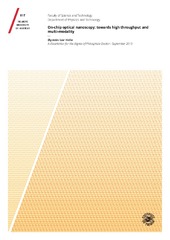| dc.contributor.advisor | Singh Ahluwalia, Balpreet | |
| dc.contributor.author | Helle, Øystein Ivar | |
| dc.date.accessioned | 2019-11-11T09:06:23Z | |
| dc.date.available | 2019-11-11T09:06:23Z | |
| dc.date.issued | 2019-11-07 | |
| dc.description.abstract | Super-resolution microscopy techniques improve the resolution of the optical
microscope beyond the diffraction limit of light. A range of different techniques
demands different optical configurations and clever illuminating strategies
to enhance the resolution. This has led to the development of advanced instrumentation,
where the super-resolution mechanisms are adding both cost
and bulk to the microscope. Furthermore, super-resolution microscopes are
bound by high numerical aperture optics, which produce convincing images,
but lack throughput. A common feature of most optical microscopes is the sample
glass/coverglass arrangement used to mount samples before and during
imaging. These have traditionally been neutral devices where the properties of
the glass itself have mostly remained unused. In this thesis, a new direction in
super-resolution imaging is introduced, where the sample glass/coverglass is
replaced with a photonic integrated circuit chip. The chip supports the sample
in the same way as the glass/coverglass, and by using optical waveguides at the
chip surface, the chip illuminates the specimen via evanescent fields. By using
high refractive index waveguides together with different geometries, the chip
can produce the necessary illumination for a range of different super-resolution
microscopy techniques. Furthermore, by exploiting the waveguide properties,
several of the imaging methods are improved over their conventional implementations.
This comes as a consequence of separating the excitation and
collection light paths for super-resolution imaging. In this work, chip-based
single-molecule localization microscopy is demonstrated with a 100 times
increase in the field of view over conventional methods, and chip-based structured
illumination microscopy is shown with a resolution beyond that of the
objective-based implementation. | |
| dc.description.doctoraltype | ph.d. | en_US |
| dc.description.popularabstract | Super-resolution microscopy techniques improve the resolution of the optical microscope beyond the diffraction limit of light. A range of different techniques demands different optical configurations and clever illuminating strategies to enhance the resolution. This has led to the development of advanced instrumentation, where the super-resolution mechanisms are adding both cost and bulk to the microscope. Furthermore, super-resolution microscopes are bound by high numerical aperture optics, which produce convincing images, but lack throughput. A common feature of most optical microscopes is the sample glass/coverglass arrangement used to mount samples before and during imaging. These have traditionally been neutral devices where the properties of the glass itself have mostly remained unused. In this thesis, a new direction in super-resolution imaging is introduced, where the sample glass/coverglass is replaced with a photonic integrated circuit chip. The chip supports the sample in the same way as the glass/coverglass, and by using optical waveguides at the chip surface, the chip illuminates the specimen via evanescent fields. By using high refractive index waveguides together with different geometries, the chip can produce the necessary illumination for a range of different super-resolution microscopy techniques. Furthermore, by exploiting the waveguide properties, several of the imaging methods are improved over their conventional implementations. This comes as a consequence of separating the excitation and collection light paths for super-resolution imaging. In this work, chip-based single-molecule localization microscopy is demonstrated with a 100 times increase in the field of view over conventional methods, and chip-based structured illumination microscopy is shown with a resolution beyond that of the objective-based implementation. | en_US |
| dc.identifier.isbn | 978-82-8236-369-3 | en_US |
| dc.identifier.uri | https://hdl.handle.net/10037/16641 | |
| dc.language.iso | eng | en_US |
| dc.publisher | UiT Norges arktiske universitet | no |
| dc.publisher | UiT The Arctic University of Norway | en |
| dc.relation.haspart | Paper 1: Helle, Ø.I., Øie, C.I., McCourt, P. & Ahluwalia, B.S. (2015). Chip-based optical microscopy for imaging membrane sieve plates of liver scavenger cells. <i>Proceedings of SPIE, 9554</i>, Nanoimaging and Nanospectroscopy III, 95540O. Also available in Munin at <a href=https://hdl.handle.net/10037/8943>https://hdl.handle.net/10037/8943. </a><p>
<p>Paper 2: Tinguely, J.-C., Helle, Ø.I. & Ahluwalia, S. (2017). Silicon nitride waveguide platform for fluorescence microscopy of living cells. <i>Optics Express, 25</i>(22), 27678-27690. Also available in Munin at <a href=https://hdl.handle.net/10037/11741>https://hdl.handle.net/10037/11741. </a><p>
<p>Paper 3: Diekmann, R., Helle, Ø.I., Øie, C.I., McCourt, P., Huser, T.R, Schüttpelz, M. & Ahluwalia, B.S. (2017). Chip-based wide field-of-view nanoscopy. <i>Nature Photonics, 11</i>, 322-328. The paper is not available in Munin due to publisher restrictions. Final version available at <a href=https://doi.org/10.1038/nphoton.2017.55>https://doi.org/10.1038/nphoton.2017.55. </a>Accepted manuscript available in Munin at <a href=https://hdl.handle.net/10037/11998>https://hdl.handle.net/10037/11998. </a><p>
<p>Paper 4: Helle, Ø.I., Coucheron, D.A., Tinguely, J.-C., Øie, C.I & Ahluwalia, B.S. (2019). Nanoscopy on-a-chip: super-resolution imaging on the millimeter scale. <i>Optics Express, 27</i>(5), 6700-6710. Also available in Munin at <a href=https://hdl.handle.net/10037/16315>https://hdl.handle.net/10037/16315. </a><p>
<p>Paper 5: Helle, Ø.I., Dullo, F.T., Lahrberg, M., Tinguely, J.-C. & Ahluwalia, S. (2019). Structured illumination microscopy using a photonic chip. (Manuscript). | |
| dc.rights.holder | Copyright 2019 The Author(s) | |
| dc.rights.uri | https://creativecommons.org/licenses/by-nc-sa/4.0 | en_US |
| dc.rights | Attribution-NonCommercial-ShareAlike 4.0 International (CC BY-NC-SA 4.0) | en_US |
| dc.subject | VDP::Mathematics and natural science: 400::Physics: 430::Electromagnetism, acoustics, optics: 434 | en_US |
| dc.subject | VDP::Matematikk og Naturvitenskap: 400::Fysikk: 430::Elektromagnetisme, akustikk, optikk: 434 | en_US |
| dc.subject | VDP::Technology: 500::Nanotechnology: 630 | en_US |
| dc.subject | VDP::Teknologi: 500::Nanoteknologi: 630 | en_US |
| dc.subject | VDP::Mathematics and natural science: 400::Physics: 430 | en_US |
| dc.subject | VDP::Matematikk og Naturvitenskap: 400::Fysikk: 430 | en_US |
| dc.subject | Integrated optics | en_US |
| dc.subject | Optical nanoscopy | en_US |
| dc.title | On-chip optical nanoscopy: towards high throughput and multi-modality | en_US |
| dc.type | Doctoral thesis | en |
| dc.type | Doktorgradsavhandling | no |


 English
English norsk
norsk
